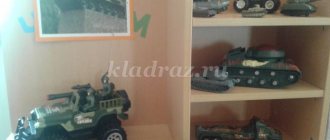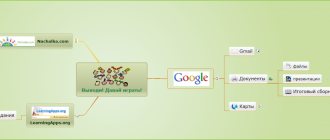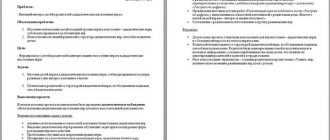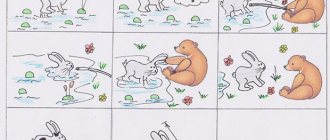Goals of learning to create crafts from waste material in kindergarten, specific tasks and techniques
Waste construction is a productive activity based on creative modeling using a wide range of non-traditional materials to give new life to the world of things that are usually thrown away.
The main goals of designing from waste material are the development of children's creative, intellectual and artistic abilities, as well as environmental education.
By making a variety of crafts (toys, furniture, vehicles), children learn to find unexpected uses for specific waste materials: plastic bottles and plates, containers for Kinder surprises, lids, corks, computer disks, packaging boxes, candy wrappers, polystyrene foam, foam rubber, etc. .
By making a variety of crafts, children learn to find unexpected uses for specific waste materials.
In the process of children constructing crafts from waste materials, teachers strive to achieve the following tasks:
- Three to four years: introduce children to the interesting possibilities of unusual materials (foam rubber, polystyrene foam, plastic bottles, etc.);
- learn to use plasticine, glue, wire, threads, etc. to connect parts and pieces;
- develop fine motor skills.
- develop cognitive and research activities;
- teach children to coordinate their actions in the process of collective work;
By creating original crafts from waste materials, children develop creative thinking.
Techniques for teaching design from waste material are traditionally built on an imitative basis and have their own characteristics at different stages:
- Stage one - detailed analysis of a sample of the future product:
- in the younger group, a craft made in advance by the teacher is used as a model;
- in the middle group, children can be asked to look at a picture or drawn image;
- at the age of six, children are already able to analyze the diagram or model of a toy; the analytical activity of children includes identifying the main parts of the toy and the material from which it is made, discussing clarifying questions, for example: what material for the craft can still be considered;
- what options for fastening parts will be optimal;
- what additional techniques can be used to design details, for example, modeling from plasticine, drawing with felt-tip pens, pencils, paints or applique elements.
- Stage two - children are taught to plan and think about step-by-step progress towards a goal, and are taught a holistic perception of the entire work process. It is specified in what sequence the parts are made, from what material, and which tool will be preferable. The choice of pedagogical techniques is carried out taking into account the age of the children:
- in younger groups, the teacher demonstrates in detail all the stages of constructing a craft, accompanying it with clear and detailed comments;
- in the middle group, the teacher gradually reduces the process of full demonstration and detailed explanation, involving active work with diagrams and supporting plans in the form of schematic sketches drawn by the children themselves.
- Stage three - the method of fastening parts and parts of the structure is thought out:
- in the middle group, plasticine is used as a connecting material;
- older children use glue, thread, wire, etc.
- Stage four provides for children to independently select the necessary material and tools for work.
- Stage five - children independently cope with the entire process of making crafts, from the emergence of a mental prototype of a toy to the substantive embodiment of a creative idea. At this stage, it is important to encourage the manifestation of creative imagination and the child’s desire for independence in the process of practical implementation.
- Stage six - summing up, analysis and evaluation of finished products. It is important to find positive aspects in the work of each child, support and inspire. An excellent technique at this stage would be an exciting role-playing or theatrical game using toys made by children, this will help them feel the significance of their work.
Older preschoolers can independently cope with the process of preparing parts
Middle group
Children's crafts from waste material for the middle group for slightly older children? The following design ideas will suit them:
Rattles. You can create unusual toys using bottles, Kinder surprise containers, using plasticine and small decorations here and there.
Christmas tree toys. For the New Year, you can make simple and cute decorations and beads for the Christmas tree using the appliqué and sculpting techniques.
Note!
Crafts made from polymer clay | Step-by-step master class on creating beautiful craftsDIY epoxy resin crafts - options for original crafts, step-by-step instructions for pouring and making them yourself
Lego crafts: step-by-step master class on creating simple DIY crafts + original versions of Lego products (photo + video)
A bouquet of flowers or a single flower made from pencil shavings, thread, rain, tinsel, ribbons.
Fish. It is very interesting to cut out fish from light foam plastic; they can be painted and added to the decor.
Doll furniture. With your children, make small interior items from cardboard, matchboxes, plastic jars, and sweet containers. You will need scissors, glue, paper, cardboard, beautiful little things for decoration, unnecessary stickers.
Parade of military equipment. Play Victory Day, build small tanks and ships from boxes, jars, buttons, lollipop holders, and various interesting unnecessary parts.
Dolls made from scraps. Make a figure out of a rag, tie knots, come up with dresses, a name for the doll, draw a face.
Note!
Christmas crafts - how to make them yourself? 150 photos of the best themed craftsCrafts made from stones: creative options for crafts made from stones + step-by-step instructions for making your own, methods and schemes of work
Crafts from disks: a step-by-step master class on how to create them yourself, creative ideas for crafts of varying complexity + simple patterns for beginners
Chrysanthemums. Cut the cups into vermi and glue the ends together to create a flower with lush petals.
Cloth
You can also make interesting and funny clothing models from waste - DIY crafts from waste material. Make a dress for a girl from newspapers, bags, cups or plates. Do fittings, catwalks and fashion shows, it’s fun and greatly develops the imagination of future fashion designers, teaches outside-the-box thinking.
How to make craft clothes from recycled materials or disposable tableware:
- first build a base of fabric or paper;
- stick on the decor parts;
- lay out the skirt using large pieces;
- the parts should be placed on top of each other diagonally so that the edges overlap;
- make “flashlight” sleeves from bent plates;
- Lay out the top layer of the dress with spoons, gluing them in layers (it’s better not to use forks, so as not to get scratched).
You can also make good dresses from canvas bags, as do crafts from garbage. You can make a whole theatrical production with actors in the roles of the goblin, the Scarecrow, the Woodcutter, and forest animals. The main thing is to have the basics in the form of shorts and T-shirts, the rest of the details are laid on top.
Now you know what crafts can be made from waste material for kindergarten. Do not limit the imagination of children, who will definitely get carried away by creativity. Crafts are a second life for unnecessary things for school and home. If they start generating their own ideas, then the day has not been wasted!
Creative experiments in the country
During your summer holiday in the village with your grandmother or at the dacha, you can also have a great time on a rainy day or in the garden, in the fresh air, creating wonderful craft toys from garbage with your own hands.
It is very simple, and the materials, traditionally, will be useful only in the most primitive ways. The main thing is ingenuity and imagination. What you can do with children:
- a town with houses for fairies;
- ladybugs, bees;
- garlands for home and garden;
- mailbox decorations;
- decorations for trees and fences.
You can use anything that comes to mind and that you don’t mind for crafts made from waste materials. For example, the basis of many designs will be 0.5 liter plastic bottles; you also need paints, paper flowers, glue, scissors, yoghurt and kinder surprise cases. Paint the bottles, make a cut in the center and cut out windows. You can stick pieces of cardboard on top, imitating brickwork.
Fill the fairy house with toys and accessories, also made by yourself. And the design of a garden, fence, barn or dog house can be entrusted to children - let them paint and decorate the space themselves.
Older children
Crafts from waste material for kindergarten - the preparatory group in the garden will be able to create the following projects together with the teacher:
Musical instruments. To play musicians and create basic instruments, take yogurt cups, fishing line, wire, boxes and wooden containers.
Castle from a fairy tale. With your children, construct towers and fortress walls from plastic bottles and colored paper, and decorate finished buildings and structures.
African savanna. You can create giraffes and zebras from boxes and colored paper, coloring them with stripes with felt-tip pens.
Clowns in the circus. Cute clowns are made using candy wrappers, cardboard, thread and glue. These are very simple DIY crafts made from waste material.
Thumbelina or The Little Mermaid. The heroines of Andersen's fairy tales are also crafts made from waste materials. They come from wire frames, pieces of plastic, beads and colored hair yarn.
Space theme. Cosmonauts in spacesuits can easily get their plates and bottles out of plastic; cocktail straws and paper parts will come in handy. Don't forget to draw the country's flag on the overalls and make a cord connecting the space explorers to the rocket.
Round dance of friends. Cheerful little men, boys in pants and girls in skirts who dance in circles holding hands can be made perfectly from colored paper and juice boxes (thick cardboard is a good basis for silhouettes).
Forest babies. Any forest animals (bunnies, owls, fox cubs, bear cubs) are easily made from toilet paper rolls, which serve as a blank for the body. Heads, paws and tails can be attached with applique, details can be drawn with a felt-tip pen.
Aircraft. The model is based on a plastic bottle onto which parts are glued - wings, tail, emblems.
Royal crown. For crafts made from waste material for kindergarten, use disposable plates that can be cut in half, sew on diamond buttons, and various decorative details.
Puppet Theater named after Buratino. Create a theater stage from shipping boxes, dolls from scraps, and props from bottles and boxes. Postcards are useful to decorate the curtain; the screen can be made from corrugated paper. You can move the dolls on translucent plastic tubes that are attached to the top of their bodies.
Additional tools
For successful work, it is important to prepare everything you need in advance. Traditionally, “waste” creativity uses:
- scissors;
- glue gun;
- scotch;
- hole punchers, pliers, round nose pliers,
- needle, thread
The list of auxiliary materials, of course, can be continued. The main thing is to prepare everything in advance so as not to be distracted while working.





